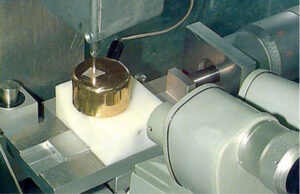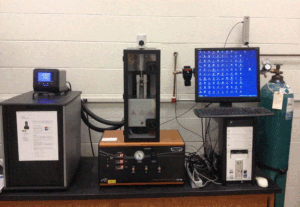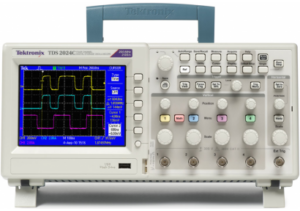
Electrical Insulation Research Center
Location
Campus Address
Science 1
Mailing Address
25 King Hill Road, Unit 3136
Storrs, CT 06269-3136
Instrumentation

Broadband Dielectric Spectroscope
Combining the time-domain technique with frequency-domain spectroscope comprises a Broadband Dielectric Spectroscope System for measuring various polarization/relaxation processes, conductivity and electrochemical impedance over a wide range of frequency and temperature (10-4 Hz – 1 GHz, -70oC-300oC). The Time Domain Technique (10-4 Hz to 10 kHz) provides one of the best ways of measuring the conductivity of polymeric samples, with a lower limit in the range of 10-15 to 10-16 S/m over the above temperature range, while frequency domain impedance analyzers extend the measurement frequency range to 1GHz (Hioki 3532-50/Agilent 4285A/HP4191).

Modified Sawyer-Tower Ferroelectric Tester
A modified Sawyer-Tower ferroelectric tester is available for the measurement of the P-E loop of a ferroelectric device, i.e., the charge or polarization developed against the electric field at a given frequency. The setup is designed for polarization study under high electric field (+/-10kV) at frequency up to 1kHz.

Pulsed Electroacoustic Space Charge Profiling
Charge injection and transport under high electric field play a key role in the ageing and ultimate failure of engineering dielectrics (breakdown). Quantitative measurement of high field conduction is essential for new material development. The application of a voltage pulse with nanosecond rise time to a dielectric sample under high field induces a transient displacement of space charge by the Coulomb effect which in turn generates an acoustic pressure wave propagating across the sample. The intensity and temporal information of the pressure wave signal detected by piezoelectric sensor at the opposite electrode is de-convoluted into spatial information of space charge (and polarization) by using signal processing. This Pulsed Electroacoustic Space Charge Profiling technique can measure high field charge injection and conduction for both flat coupon and cylindrical sample (power cables) with a spatial resolution of 5 micron. Higher resolution can be achieved with lithium niobate based sensory.

High Field Conduction-Guarded Needle
Carrier mobility-related prebreakdown phenomena can only be studied within microscopic dimensions, as the power dissipation would cause thermal runaway for a macroscopic geometry. The guarded needle apparatus is designed for such measurement, using a sharp metal needle to create local high electrical field, which induces carrier mobility. A guarded needle electrode with a tip radius in the range of 5 µm and an electrical guard which extends to within about 35 µm of the tip provides the basis for measuring high-field mobility as the resistive current can be measured independent of the displacement current with a background noise level in the 5 fC range. Thus, the guarded needle measurement provides a level of quantitative detail that cannot be achieved through simpler measurements.

Thermal Conductivity Meter
The DTC-300 measures thermal conductivity of a variety of materials, including polymers, ceramics, composites, glasses, rubbers, some metals, and other materials of low to medium thermal conductivity. Only a relatively small test specimen is required. Nonsolids, such as pastes or liquids, can be tested using special containers. Thin films can also be tested accurately using a multilayer technique. The tests are in accordance with the ASTM E1530 Standard.

Other Equipment
- High Voltage Test Transformers
- Partial Discharge System
- High Frequency/High Temperature Aging
- Tracking Resistance
- HV Switchers for Pulse Discharge Energy Density Characterization
- Automatic Film Breakdown Tester
- Digital (Stanford Research Systems SR830) and Analog Lock-in Amplifiers
- High voltage Capacitance and Tan-delta Bridge
- Salt-Fog and Clean-Fog Chamber
- Tektronics Oscilloscopes (200 MHz to 1 GHz)
- Keithley fA meters